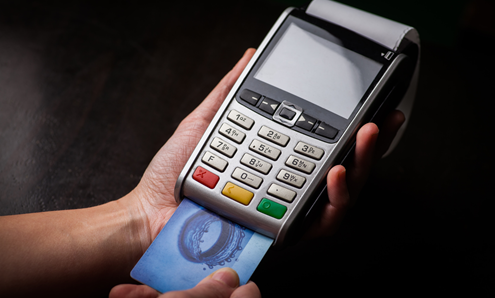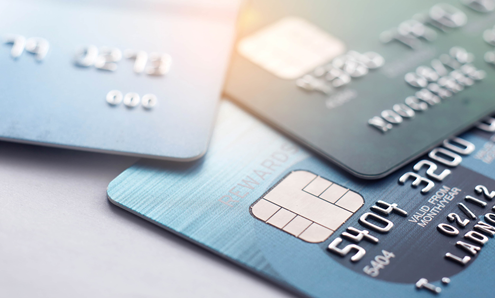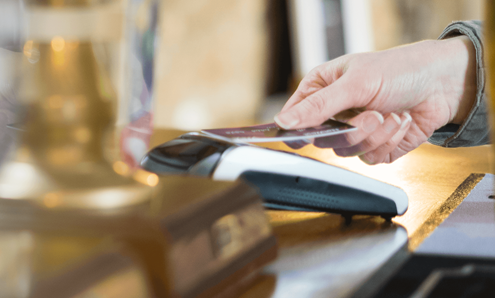9 bank cards explained: What are credit, debit, virtual cards and more
21 December 2023 | Published by Jodie Wilkinson
Bank cards are a staple in wallets all over the world. From a restaurant owner eyeing a speedy transaction solution to an online startup seeking a secure payment method, the choices are vast and varied. Lost your card? No worries, a virtual card has got your back. Managing business expenses? A corporate card might just be your new best friend.
However, with such a wide range of choices, knowing the differences and understanding which option best suits your needs can be challenging.
To help you find the best payment card choice, we’ve pulled together a comprehensive guide to some of the most common types of plastic available. Find out what they are, how they work, and what they can offer you, your business, and your customers.
What is a bank card?
Firstly, let’s dig into what a bank card is. Also called payment cards, they are physical or digital tools that can be used in place of cash. They are often connected to your bank account or funds and give you access to your money without having to physically handle coins and notes.
Bank cards come in various forms, each designed to cater to specific financial needs and scenarios. They’re more than just a means of payment; they enable us to manage our finances, track spending, and even earn rewards.
Each type of payment card offers a unique set of features and benefits, but they can typically be recognised by some key features:
Card number – A series of raised or printed digits on the front, usually 16 numbers, representing the cardholder's account number.
Cardholder's name – The name of the individual or organisation authorised to use the card, usually printed below the card number.
Expiration date – Indicated on the front, showing the month and year after which the card will no longer be valid.
Card issuer logo – The logo of the issuing bank or financial institution, typically located on the front.
Card network logo – Logos of card networks like Visa, MasterCard, or American Express indicating where the card is accepted.
EMV chip – A small metallic square on the front, known as an EMV chip, which enhances security for transactions.
Contactless symbol – A symbol that looks like a Wi-Fi signal, indicating that the card supports contactless payments.
Credit card
Credit cards allow you to borrow funds up to a pre-agreed limit from a credit institution, like a bank, to make purchases or withdraw cash.
Credit cards can be extremely useful for people who need funds immediately but don’t have the cash in their bank account at that moment in time. They allow you to defer the payment, but you must pay back the borrowed amount at a later date, usually with interest, according to the card issuer's terms. While useful, users can rack up costly fees if the borrowed money isn’t paid back on time. To mitigate this, credit card companies will set limits based on your credit score, which is essentially a rough indicator of your creditworthiness, and increase the required charges for late payments or exceeding credit limits.
Credit cards are one of the most widely used payment methods across the globe for everything from everyday payments to utility bills. They can be used at physical point-of-sale (POS) systems in brick-and-mortar stores and online payment gateways for e-commerce transactions, and they’re compatible with cash machines for taking out cash.
There are several types of credit cards available for different people and purposes:
Rewards credit cards – These offer rewards like cash back, points, or miles on purchases.
Balance transfer credit cards – These cards have low or no interest on transferred balances from other credit cards.
Secured credit cards – These require a security deposit, making them ideal for building or repairing damaged credit.
0% APR credit cards – These cards have no interest fees on purchases made within a set introductory period, helping users to spread the cost of payments over a longer timescale.
Business credit cards – These are specifically for business use, so they’ll tend to have higher credit limits for more costly transactions.
Student credit cards – These are often aimed at people under 21 to help them build up a credit score. They tend to have lower credit limits.
Store credit cards – These are issued by a store and can only be used at specific participating retailers.
How do credit cards work?
When you make a purchase, your card issuer pays the retailer on your behalf, and you can continue to make payments up to your credit limit.
At the end of your monthly billing cycle, you’ll receive a statement for your purchases and must repay your issuer, either fully each month or in smaller instalments over time. Any unpaid balance generates interest, which you must also pay off.
Credit card benefits
- Widely accepted and easy to use
- Many offer rewards, cashback, or travel benefits
- When used responsibly, they can improve credit scores
- Has stronger fraud protection and extended warranties than other card types
- Useful in emergencies or when cash flow is low
Credit card drawbacks
- Can be costly if balances aren't paid in full
- Easy to overspend and accumulate debt
- Potential for annual fees, late payment fees, and foreign transaction fees
- Late payments or high balances can negatively affect credit scores
Debit card
While credit cards give you access to a line of credit, debit cards let you spend your money using the funds you already have in your bank account. This means that when you make a purchase with a debit card, the amount is immediately deducted from your account. If you don’t have enough money to cover the cost of your purchase, your transaction will be declined. Some bank accounts may include an overdraft to dip into if you need more funds than you have available, but these often come with fees and you’ll have to pay back the borrowed money at a later date.
Debit cards tend to be accepted in the same places and with the same methods as credit cards, making them just as accessible and user-friendly. Along with paying for online and in-person purchases, you can also use debit cards to take out money from a cash machine. Essentially, they give you an efficient way to directly access your money, offer a convenient alternative to carrying cash, and allow you to track your spending.
How do debit cards work?
To buy something using a debit card, the merchant will send a request to your bank to check that there are enough funds in your account. If the money is available, the transaction is approved, and the amount is immediately deducted from your bank account.
At the end of the month, your bank will send out a statement that logs all your transactions.
Debit card benefits
- You can only spend what you already have, reducing the risk of building up debt
- Accepted in most places where credit cards are used
- No borrowing involved, so there are no interest fees
- Easy to carry, use, and track spending
- Can be used to withdraw cash
Debit card drawbacks
- There’s a risk of overdraft fees if you spend all the money in your account.
- Typically, they have less protection against fraud compared to credit cards
- Does not contribute to building a credit history
- Fewer rewards and benefits compared to credit cards
Prepaid card
Prepaid cards are another type of card that lets you pay for purchases with money you already have. This time, the money is pre-loaded onto the card rather than linked to your bank account, like a debit card. Once the funds on the prepaid card have been spent, they can’t be used for any more transactions until you top them up with more funds.
While each prepaid card will have its own card number and expiration date, it’s not linked to a bank account and you don’t have to have a bank account to use one. You can keep adding funds to the card and using it until it expires.
Prepaid cards are accepted in most places where credit or debit cards are used and offer the same chip and PIN and contactless services. The benefit of using prepaid cards is that you have a lot more control over your spending and they can make it easier to budget, as you can only spend the money you load onto the card and there’s no risk of running up debts. This makes them a handy way to teach teenagers and young adults about finance management.
How do prepaid cards work?
Before using a prepaid card, you must load money onto it through a bank transfer, direct deposit, or at designated retail locations. Once the cash is on the card, it’s ready to spend.
When making purchases, the amount is deducted from the card's balance. Once the balance is depleted, the card can either be reloaded with more funds (in the case of reloadable cards) or disposed of if it's a single-use card.
Prepaid card benefits
- You can only spend the amount that’s loaded onto the card
- Accessible to those with poor or no credit history
- Can be used wherever credit or debit cards are accepted
- No risk of spending beyond the card's balance
- Useful for people without traditional bank accounts
Prepaid card drawbacks
- Can come with various fees, which can add up over time. This could include monthly, transaction, withdrawal, and reload fees.
- Use of prepaid cards won’t help build up your credit history
- May offer fewer protections against loss or theft compared to credit or debit cards
Charge card
Charge cards are most comparable to credit cards: they let you pay for products and services by borrowing the money from a bank or financial institution. However, you must pay back the entire balance at the end of each billing cycle; your balance cannot be carried over into the next billing period.
While credit cards let you split out the cost of what you owe and charge you interest fees if you can’t pay it back, charge cards don’t typically come with interest rates as they don’t expect that your balance will need to roll over into the next month. Charge cards also don’t tend to have spending limits.
You can use charge cards in most retail and hospitality locations as well as online, for withdrawing cash, and for mail-order purchases, but they tend to be less commonly accepted than credit or debit cards. Fewer banks and card providers issue charge cards.
They’re also often provided as business cards to employees to help companies track spending. Or, they’re aimed at people with higher incomes and a strong credit history. Many will even have a minimum salary criteria you must meet to be accepted for one, for example, those earning over £50,000 per year. This works in a similar way to having a high credit score; it’s a way to help reassure providers that you can pay back any money you spend on the card.
How do charge cards work?
When you purchase something with a charge card, you’re agreeing to pay the amount back in full at the end of your billing cycle. Your bank will provide a loan to cover the funds, but they must be repaid completely.
If you fail to pay the full balance, you won’t be charged interest on the outstanding balance. Instead, you could face significant late fees or penalties much more costly than interest.
Charge card benefits
- Flexibility for spending, particularly beneficial for high spenders or businesses
- Often includes rewards programs and benefits like travel perks
- Paying back on time can strengthen your credit history
Charge card drawbacks
- You must pay off the balance in full each month
- Late payments can result in substantial fees or interest charges higher than those issued by credit card companies
- May charge annual usage and cash withdrawal fees which can add up
- No option to make minimum payments or spread out the cost of purchases
Virtual card
Virtual cards are digital versions of traditional payment cards created for online or contactless transactions. Unlike physical cards, they only exist electronically and are stored in a digital wallet on devices like phones or smartwatches. You won’t be issued a plastic card and must have your device to use your virtual card. Your virtual card will have a unique 16-digit card number, expiration date, and card verification value (CVV) code like a plastic card.
Since virtual cards are designed for electronic use, they’re primarily intended for use on the internet with all online payment gateways that accept standard card payments, over the phone, or for any transactions where the card is not physically presented. The drawback to this is that they have limitations for physical transactions; they can’t be used in traditional in-store settings like chip and pin purchases or cash withdrawals.
Major card issuers offer virtual cards, and most online retailers and service providers accept them for standard credit or debit card payments.
How do virtual cards work?
As each virtual card is generated with a unique card number, expiration date, and security code (CVV), they work in the same way as traditional bank cards.
When used for an online purchase, the details are entered just like a physical card and the virtual card is linked to a real account. However, with a virtual card your details aren’t shared, or will be randomly generated, so your bank account information isn’t revealed for each transaction.
Virtual card benefits
- Reduces the risk of fraud in online transactions as your information is kept private
- Limits can be set on usage
- Easy and quick to use for internet transactions
- Don’t need a physical card to use them
Virtual card drawbacks
- Can’t be used for certain transactions
- May have limitations on where and how they can be used
- Requires internet access for transactions and card management
Gift card
Gift cards are pre-loaded payment cards used as an alternative to traditional gifts. They can be brand-specific or general-purpose and allow you to purchase goods or services up to the value loaded onto the card. Gift cards generally last for one or two years before expiring, and once the funds have been used up, they can’t be reloaded again.
Brand-specific gift cards, also called closed-loop gift cards, can only be used at the store that issued them. General-purpose gift cards, known as open-loop gift cards, can be used wherever these cards are accepted and are often branded with major card issuers like Visa or Mastercard.
Gift cards are a popular choice for giving as gifts, business incentives, or rewards. It means that the receiver can choose what they want to spend the money on when it’s convenient for them.
How do gift cards work?
Gift cards are pre-loaded with a set amount of money. When used, the purchase amount is deducted from the card's balance. You can continue to make multiple transactions until the card value is depleted.
Gift card benefits
- Allows recipients to choose their own gifts
- Easy to purchase and give
- Available from a variety of retailers and services
- Less risk than giving cash
Gift card drawbacks
- Some gift cards are restricted to specific stores or services
- Can lose value over time or expire if not used
- Typically cannot be exchanged for cash
Cards for businesses
Business credit cards
Business credit cards are a specific type of credit card designed solely for business use. They’re intended to help manage company expenses and track employee spending, and they often come with features and rewards tailored to business needs. They’re usually available for companies of all sizes, including sole proprietors, limited companies, and freelancers.
Business credit cards work and are accepted in the same locations as personal credit cards, except they’re issued for business expenses such as travel, office supplies, client entertainment, and equipment. They offer a convenient way to separate personal and business finances, which is crucial for accounting and tax purposes.
These types of credit cards may also have different fee structures, interest rates, higher credit limits, and rewards or benefits specific to business use. And, just like with personal credit cards, business owners are liable for any debt built up on a card, which can negatively impact credit scores.
Corporate cards
While business credit cards are aimed at companies of all sizes, corporate cards are aimed at larger and more established organisations. They offer many of the same benefits as business cards – like rewards, an easy way to manage expenses, and allowing employees to become cardholders – but they have strict guidelines that allow businesses to qualify for one.
Depending on the provider, businesses must:
- Be earning over a certain annual revenue
- Meet a minimum annual spend amount
- Have a strong credit score
- Complete a more stringent and lengthier application process
Another difference between business and corporate credit cards is that the business itself is liable for any late payments or debt, rather than the business owner. Spending limits and fees are often also higher.
Travel and entertainment cards
Travel and entertainment (T&E) cards are a type of payment card specifically designed for work-related travel and entertainment use. They’re tailored to meet the needs of business travellers who incur expenses for things like flight or train tickets, hotel costs, restaurants, and car rentals. T&E cards mean employees don’t have to use their personal cards, and their company can access extra rewards associated with these expenditures.
Frequently asked questions about bank cards
What are the typical fees associated with different types of cards?
Several fees are associated with payment cards, which vary depending on the card type and provider. Some standard fees are:
Annual fee – A yearly charge for being issued and using a card. These are often associated with credit cards that offer significant rewards or benefits.
Monthly fee – A monthly fee for maintaining certain types of accounts, such as prepaid and some debit cards.
Transaction fees – Charges for specific transactions. This can include balance transfers on credit cards or foreign transactions on both credit and debit cards.
Late payment fee – A charge that mainly applies to credit cards when you fail to make the minimum required payment by the due date.
Cash advance fee – A fee charged when using a credit card to withdraw cash from a cash machine or bank. This fee is usually a percentage of the amount withdrawn.
Over-the-limit fee – Charged on a credit card if you exceed the credit limit set by your card issuer.
Foreign transaction fee – Applied when a transaction is made in a foreign currency or passes through a foreign bank. Common for both credit and debit cards used internationally.
Card replacement fee – Charged for issuing a replacement card if the original is lost, stolen, or damaged.
What is a floor limit?
A floor limit is the maximum amount a merchant can charge to a credit or debit card without authorisation from the cardholder's bank. Historically, this was an important concept when transactions were processed manually. Today, with modern electronic systems, most trades are authorised electronically, rendering the traditional concept of a floor limit less common.
What are the benefits of using a business credit card over a personal credit card for company expenses?
As a business owner, keeping track of and managing cash flow is crucial for business operations – and to help you keep an eye on your bottom line. Here are some of the key benefits of using a business credit card for company expenses:
- Business credit cards often come with tools to categorise and track expenses, making it easier to manage company finances.
- Separating personal and corporate expenses makes financial reporting and tax declaration easier
- Business credit cards typically have higher credit limits to accommodate larger work expenses
- Access to rewards programs tailored for businesses, like discounts on travel, office supplies, and even utility services
- Allow companies to issue cards to employees with custom spending limits and monitor their expenditure
Are there any tax advantages to using a business credit card?
Using a business credit card can simplify accounting and make it easier to track deductible expenses. It also helps maintain a clear separation between personal and business finances, a crucial aspect of tax audits. While using the card itself doesn't directly result in tax advantages, the clear separation and easy tracking of business expenses can indirectly benefit tax reporting and deductions.
Here at takepayments, we’re all about helping businesses thrive, whether that’s how you make transactions or how you accept them. Level up your card machine or POS system today, or contact us today to find out how we can help.





